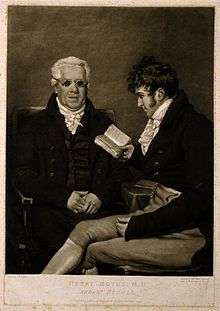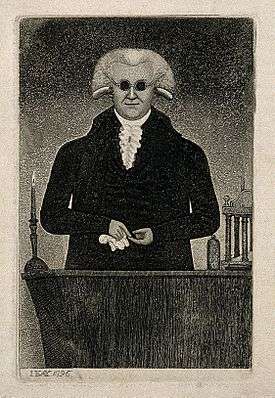Henry Moyes
Henry Moyes (1750 – 1807) was a blind Scottish lecturer on natural philosophy.[1]
Henry Moyes | |
|---|---|
 Henry Moyes. Mezzotint by W. Ward, 1806, after J. R. Smith | |
| Born | 1750 |
| Died | 1807 |
| Nationality | Scottish |
| Occupation | lecturer on natural philosophy |

Life
As an itinerant public speaker he helped raise 18th century popular interest in the new field of chemistry.[2] He mixed with the greatest engineers and scientists of the day[1] and attended the Lunar Society. In London he shared a room in George Street, Hanover Square with Adam Walker where lectures were given to small groups of gentry.[3] Moyes was described as an excellent lecturer in philosophy by Joseph Priestley.[4] His portrait was painted by John Russell.[1]
He was born in 1750 and came from a humble Kirkcaldy background and was blinded aged three by smallpox.[5] In 1766 he was befriended by Adam Smith, when the latter was in Kirkcaldy writing his Wealth of Nations. The boy showed precocious aptitude and, as well as teaching Moyes himself, Smith secured the patronage of David Hume and Thomas Reid in the young man's education.[6]
Being blind, he required assistance for demonstrations[4] and his assistant, nephew William Nicol,[7] would himself become notable for his contributions to science.
During 1784–86, he toured the United States giving successful lectures in Boston, Philadelphia, Baltimore, Princeton and Charleston, South Carolina.[1] He was elected a Foreign Honorary Member of the American Academy of Arts and Sciences in 1785.[8] Thereafter, he settled in Manchester, England, and undertook a tour of Ireland.
His brother was '"Old Moses" the dreary, drowsy, drone' (Episcopalian Minister of the Cowgate, Edinburgh).[5]
Freemasonry
Moyes was an Affiliate Member of Lodge Holyrood House (St Luke's), No.44, (Edinburgh, Scotland). It is not, yet, known in which Lodge he was Initiated. That he was totally blind was not (and is not) an impediment to his becoming a Freemason.[5]
External links
References
- A. D. Morrison-Low, ‘Moyes, Henry (1749/50–1807)’, Oxford Dictionary of National Biography, Oxford University Press, Sept 2004
- Some aspects of the history of education in analytical chemistry: published syllabi and their authors, Shaw (1734), Watson (1771), Moyes (1784, 1786) and Sullivan (1856) ; Fresenius' Journal of Analytical Chemistry ; Springer Berlin / Heidelberg; ISSN 0937-0633 (Print) 1432-1130; Issue Volume 347, Numbers 1-2 / January, 1993
- p125 Musson, Robinson
- Joseph Priestley to Joseph Banks, 6 Feb 1783, NHM, Dawson Turner MS 3, fol. 17
- Lindsay, Robert Strathern (1935). A History of the Masonic Lodge of Holyrood House (St. Lukes), No. 44 Holding of the Grand Lodge of Scotland, with Roll of Members, 1734-1934. Vol. II. T. and A. Constable at the University Press. p. 686.
- Dr James Currie to Thomas Creevey, 24 February 1793, Lpool RO, Currie MS 920 CUR
- p122 Albert Edward Musson, Eric Robinson Science and technology in the Industrial Revolution, Manchester University Press, 1969, ISBN 0-7190-0370-9
- "Book of Members, 1780–2010: Chapter M" (PDF). American Academy of Arts and Sciences. Retrieved 28 July 2014.